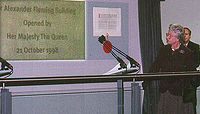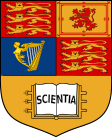Imperial College Faculty of Medicine
 Sir Alexander Fleming Building | ||||||||||
Former names | Imperial College School of Medicine | |||||||||
|---|---|---|---|---|---|---|---|---|---|---|
| Established | 2001[1] | |||||||||
| Dean | Jonathan Weber[2] | |||||||||
Academic staff | 450[3] | |||||||||
Administrative staff | 1,114 | |||||||||
| Undergraduates | 2,188 | |||||||||
| Postgraduates | 1,927 | |||||||||
| Location | , | |||||||||
| Campus | South Kensington, Hammersmith, Chelsea and Westminster, St Mary's, Charing Cross, Royal Brompton[4] | |||||||||
| Colours | ||||||||||
| Website | www | |||||||||
The Faculty of Medicine is the academic centre for medical and clinical research and teaching at Imperial College London. It contains the Imperial College School of Medicine, which is the college's undergraduate medical school.
History[]
Medical teaching at Imperial dates back to the founding of Charing Cross Hospital Medical School in 1823, which was followed by other medical schools including Chelsea and Westminster Hospital Medical School, St Mary's Hospital Medical School, and the Royal Postgraduate Medical School. These preceding medical schools were home to numerous medical researchers, including Sir Alexander Fleming, who discovered penicillin at whilst working at St Mary's.[5] St Mary's became part of Imperial in 1988, with the rest merging to form Imperial College School of Medicine in 1995.[6] To accommodate medical activities at South Kensington, the Sir Alexander Fleming building was opened in October 1998, designed by Foster + Partners and costing £65m.[1]

The Faculty of Medicine was created as part of a college-wide restructuring announced in 2001, taking over research responsibilities from the School of Medicine, which in turn was restricted to only teaching the undergraduate course.[7] The faculty has since had input on biomaterials and bioengineering courses across the college, and been reorganised into 8 academic departments.[1][8]
In early 2020, immunology research focused on finding a vaccine against SARS-CoV-2 as part of the inter-departmental COVID-19 Response Team, led by the faculty.[9] Under the leadership of professor Robin Shattock, the team made a significant breakthrough by reducing a part of the normal development time to develop the vaccine from "two to three years to just 14 days."[10][11] The research team is now at the stage of testing the vaccine on animals.[10] The faculty's 16 March 2020 report entitled "Impact of non-pharmaceutical interventions (NPIs) to reduce COVID-19 mortality and healthcare demand"[12] was described in a March 17 The New York Times article, as the coronavirus "report that jarred the U.S. and the U.K. to action".[13]
Campuses[]
The medical school is based at the Sir Alexander Fleming Building on Imperial College Road in South Kensington. It also has many hospital campuses across London with teaching, research and library facilities:[4]
The faculty also has a presence at its many other associated hospitals across London.[14]
Academics[]
The faculty is closely linked to the National Health Service, and organises research and clinical teaching through its Imperial College Healthcare NHS Trust hospitals, which is among the largest in the country, and other affiliated hospitals around London.[15][16] It has also conducted studies on strategies for improving medical teaching and student preparation.[17][18] The faculty is home to many research institutes, including the Partnership for Child Development and the London Institute of Medical Sciences, which is also a Medical Research Council institute.[19][20] It is also one of the founding institutions of the Francis Crick Institute, an inter-university medical research centre in London, and the largest biomedical laboratory in Europe.[21][22]
School of Public Health[]
The School of Public Health is the faculty's research centre for epidemiology and public health, and includes the Jameel Institute for Disease and Emergency Analytics (established with support from Community Jameel, and led by Neil Ferguson), and the Medical Research Council's Centre for Global Infectious Disease Analysis.[23][24] The school also offers postgraduate and intercalated undergraduate courses.[25] The school is to move to premises at the college's new White City campus once construction is complete.[26]
Medical school[]
The faculty offers a 6-year MBBS course through its School of Medicine, which includes an intercalated year leading to a BSc. The school also offers intercalated programmes for external students, and has partnered with Nanyang Technological University in Singapore to run its Lee Kong Chian School of Medicine, for which it has developed the medical curriculum.[27][28]
National Heart and Lung Institute[]

Based at Royal Brompton Hospital, the National Heart and Lung Institute had been part of the British Postgraduate Medical Federation, within the University of London. The National Heart and Lung Institute was the highest ranked of Imperial’s medical departments in Research Excellence Framework (REF) 2014.[29] It eventually joined Imperial in 1995, becoming part of the then School of Medicine two years thereafter.[30]
Rankings[]
The faculty ranks tied 4th in the world (with Stanford University), and 3rd in the UK, in the 2018 Times Higher Education rankings, as well as tied 11th (with UCSF) in the QS World University Rankings 2018. It is ranked 3rd for medicine in the 2018 Complete University Guide rankings,[31] 11th in the UK by the Guardian University Guide 2018,[32] and 2nd in the UK for research in the latest RAE in 2008, behind Edinburgh.
See also[]
| Wikimedia Commons has media related to Imperial College Faculty of Medicine. |
References[]
- ^ Jump up to: a b c Gay, Hannah (2007). The History of Imperial College London, 1907-2007. Imperial College Press. pp. 628, 669, 757. ISBN 9781860947087.
- ^ "New Dean of Faculty of Medicine announced". Felix. 25 May 2018. Retrieved 14 December 2019.
- ^ "Statistics Pocket Guide 2018–19" (PDF). Imperial College London. Retrieved 11 December 2019.
- ^ Jump up to: a b "Campus Information". Imperial College London. Retrieved 11 December 2019.
- ^ "Discovery and Development of Penicillin". American Chemical Society. Retrieved 11 December 2019.
- ^ "A timeline of College developments". www.imperial.ac.uk. Imperial College London. Retrieved 27 December 2018.
- ^ Live! – News: Science Faculties to Re-Merge Archived 31 December 2005 at the Wayback Machine
- ^ "New department structure in the Faculty of Medicine and New Heads of Department". 21 December 2018. Retrieved 14 December 2019.
- ^ Imperial College COVID-19 Response Team (16 March 2020). "Impact of non-pharmaceutical interventions (NPIs) to reduce COVID19 mortality and healthcare demand" (PDF).
- ^ Jump up to: a b "Coronavirus: 'Significant breakthrough' in race for vaccine made by UK scientists". Sky News. Retrieved 6 February 2020.
- ^ "Imperial researchers in race to develop a coronavirus vaccine | Imperial News | Imperial College London". Imperial News. Retrieved 6 February 2020.
- ^ Ferguson, Neil M; Laydon, Daniel; Nedjati-Gilani, Gemma; Imai, Natsuko; Ainslie, Kylie; Baguelin, Marc; Bhatia, Sangeeta; Boonyasiri, Adhiratha; Cucunubá, Zulma; Cuomo-Dannenburg, Gina; Dighe, Amy; Fu, Han; Gaythorpe, Katy; Thompson, Hayley; Verity, Robert; Volz, Erik; Wang, Haowei; Wang, Yuanrong; Walker, Patrick GT; Walters, Caroline; Winskill, Peter; Whittaker, Charles; Donnelly, Christl A; Riley, Steven; Ghani, Azra C (16 March 2020). "Impact of non-pharmaceutical interventions (NPIs) to reduce COVID-19 mortality and healthcare demand" (PDF). Imperial College of Science, Technology and Medicine: 20. Retrieved 22 March 2020.
- ^ Landler, Mark; Castle, Stephen. "Behind the Virus Report That Jarred the U.S. and the U.K. to Action - The New York Times". Retrieved 22 March 2020.
- ^ "Our NHS Trusts". Imperial College London. Retrieved 11 December 2019.
- ^ "Electives and Clinical Attachments, Faculty of Medicine". Imperial College London. Retrieved 14 December 2019.
- ^ "Imperial College Healthcare NHS Trust - Chair, HM Government Public Appointments". Cabinet Office. Retrieved 14 December 2019.
- ^ Mohiaddin, H.; Malik, A.; Murtagh, G. M. (18 April 2019). "Maximizing the acquisition of core communication skills at the start of medical training". Advances in Medical Education and Practice. Dove Press. 10: 727–735. doi:10.2147/AMEP.S212727. PMC 6717721. PMID 31695549. S2CID 203226709.
- ^ Chandrashekar, A.; Mohan, J. (29 January 2019). "Preparing for the National Health Service: the importance of teamwork training in the United Kingdom medical school curriculum". Advances in Medical Education and Practice. Dove Press. 10: 679–688. doi:10.2147/AMEP.S203333. PMC 6709809. PMID 31686942.
- ^ "Partnership for Child Development". London Centre for Neglected Tropical Disease Research. Retrieved 14 December 2019.
- ^ "LMS & Imperial College London". London Institute of Medical Sciences.
- ^ "Our Founders". Crick. Retrieved 11 December 2019.
- ^ Jha, Alok (19 June 2010). "Plans for largest biomedical research facility in Europe unveiled". The Guardian. London. Retrieved 11 August 2010.
- ^ "Abdul Latif Jameel Institute for Disease and Emergency Analytics". Imperial College London. Retrieved 18 November 2020.
- ^ "MRC Centre for Global Infectious Disease Analysis". UK Research and Innovation. Retrieved 14 December 2019.
- ^ "Study, School of Public Health". Imperial College London.
- ^ "Imperial to set up disease research centre with Saudi support". Financial Times. 15 October 2019. Retrieved 14 December 2019.
- ^ "NTU Singapore scientists convert plastics into useful chemicals using sunlight". eurekalert.org. American Association for the Advancement of Science. 11 December 2019. Retrieved 11 December 2019.
- ^ "Curriculum Development". Imperial College London. Retrieved 11 December 2019.
- ^ "About us". Imperial College London. Retrieved 16 February 2021.
- ^ "Our history and alumni". National Heart and Lung Institute. Retrieved 18 June 2020.
- ^ "Complete University Guide". Complete University Guide. Retrieved 7 May 2015.
- ^ "University League Tables 2018". The Guardian. Retrieved 18 September 2018.
- Imperial College Faculty of Medicine
- Faculties of Imperial College London
- 2001 establishments in the United Kingdom
- Educational institutions established in 2001

